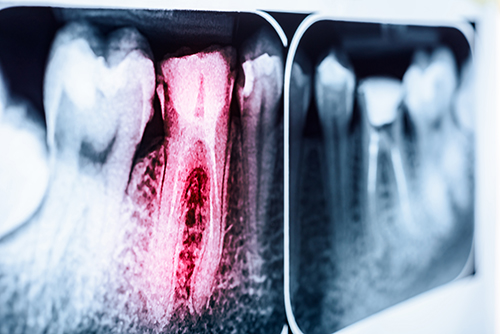![New inhibitor blocks a key virulence enzyme in oral bacteria, making it unable to stick to a tooth surface. [radub85/Getty Images]](https://genengnews.com/wp-content/uploads/2018/08/Aug11_2017_Getty_503393606_ToothDecayXRay_5001612491711-1.jpg)
New inhibitor blocks a key virulence enzyme in oral bacteria, making it unable to stick to a tooth surface. [radub85/Getty Images]
In the late 1980’s, an advertising campaign for Crest toothpaste pitted a team of toothbrush-toting superheroes against the dreaded “Cavity Creeps,” who sought to destroy the peaceful, dentally entwined city of Toothopolis. In actuality, the evil cavity creeps are bacterial species that are capable of creating sticky biofilms that allow them to be glued to the surface of teeth, eating away the enamel. Now, University of Alabama at Birmingham (UAB) investigators have created a small molecule that prevents or impedes tooth cavities in rats. Findings from the study were published recently in Scientific Reports in an article entitled “Structure-Based Discovery of Small Molecule Inhibitors of Cariogenic Virulence.”
“Our compound is drug-like, non-bactericidal, easy to synthesize, and exhibits very potent efficacy in vivo,” the authors wrote. It is “an excellent candidate that can be developed into therapeutic drugs that prevent and treat dental caries.”
The inhibitor molecule blocks the function of a key virulence enzyme in an oral bacterium, a molecular sabotage that is akin to throwing a monkey wrench into machinery to jam the gears. In the presence of the molecule, Streptococcus mutans—the prime bacterial cause of the tooth decay called dental caries—is unable to produce biofilms. Interestingly, this selective inhibition of the sticky biofilm appeared to act specifically against S. mutans and drastically reduced dental caries in rats fed a caries-promoting diet.
“If we have something that can selectively take away the bacteria's ability to form biofilms, that would be a tremendous advance,” noted co-senior study investigator Sadanandan Velu, Ph.D., associate professor of chemistry in the UAB College of Arts and Sciences.
About 2.3 billion people worldwide have dental caries in their permanent teeth, according to a 2015 Global Burden of Disease study. Current practices to prevent cavities, such as mouthwash and tooth brushing, indiscriminately remove oral bacteria through chemical and physical means and have limited success.
S. mutans creates its glucan biofilm through the activity of three glucosyltransferase (Gtf) enzymes. The crystal structure of GtfC is known, and the UAB researchers used that structure to screen—via computer simulations—500,000 drug-like compounds for binding at the enzyme's active site.
Ninety compounds with diverse scaffolds showing promise in the computer screening were purchased and tested for their ability to block biofilm formation by S. mutans in culture. Seven showed potent, low-micromolar inhibition, and one, #G43, was tested more extensively.
“This is particularly exciting in the broad sense of targeting microbiota using chemical probes tailored to the specific pathogen within a complex microbial community,” remarked co-senior study investigator Hui Wu, Ph.D., professor of pediatric dentistry and director of UAB Microbiome Center. “Successful development of this selective lead inhibitor in the dental setting offers a proof of concept that selective targeting of keystone bacteria is promising for the design of new treatments. This is relevant for many elusive human diseases as the microbiome is being linked to overall health and disease.”
The #G43 compound inhibited the activity of enzymes GtfB and GtfC, with micromolar affinity for GtfB and nanomolar affinity for GtfC. #G43 did not inhibit the expression of the gtfC gene, and it did not affect growth or viability of S. mutans and several other oral bacteria tested. Also, #G43 did not inhibit biofilm production by several other oral streptococcal species.
In the rat model of dental caries, the animals on a low-sucrose diet were infected with S. mutans, and their teeth were treated topically with #G43 twice a day for four weeks. The #G43 treatment caused very significant reductions in enamel and dentinal caries.
“In conclusion,” the authors wrote, “using structure-based design, we have developed a unique low micromolar biofilm inhibitor that targets S. mutans Gtfs through binding to key virulence factors, Gtfs.”


